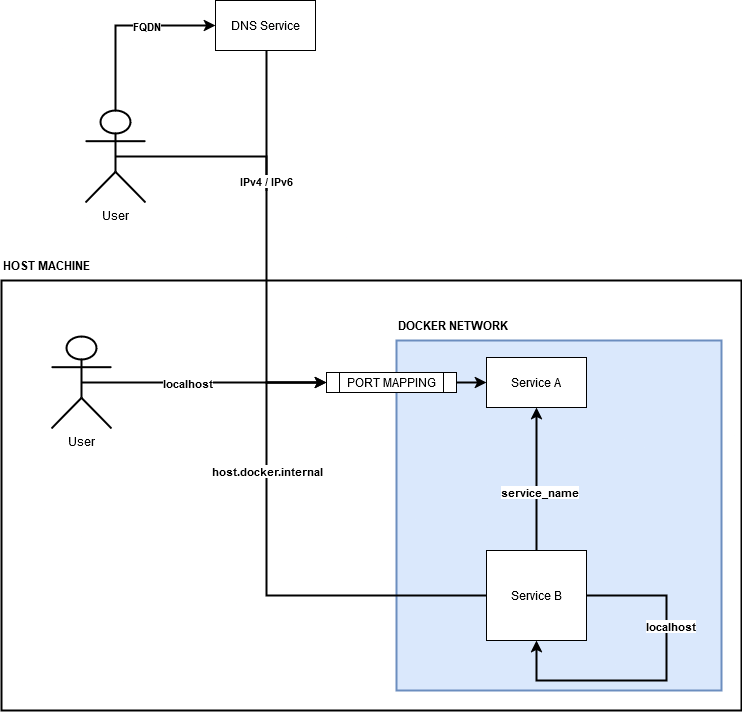Docker networking is powerful but can be confusing, especially when dealing with communication between the host machine and Docker containers. Many developers assume that network behavior inside a Docker network works the same as on the host, leading to unexpected issues. In this post, we’ll explore common pitfalls when running services with Docker Compose and how to handle them correctly.
The Basics: Host vs. Docker Network
Docker Compose creates an isolated network for services to communicate. Each container gets a unique DNS name corresponding to its service name in docker-compose.yml. However, the way networking works inside Docker is different from how it works on the host machine.
Host Perspective (External Access)
When accessing a service from the host machine (outside Docker), you must use localhost and the mapped port:
curl http://localhost:8080 # Accessing a container-bound service via a mapped port
You cannot use Docker-internal DNS names (such as service_name) or host.docker.internal from the host machine.
Docker Container Perspective (Internal Communication)
Containers within the same Docker network can refer to each other by service name:
curl http://app-store:5000 # Works inside Docker
But if a container needs to communicate with a service running on the host machine, it must use host.docker.internal:
curl http://host.docker.internal:3000 # Works inside Docker to reach host
Common Pitfalls and How to Solve Them
Pitfall 1: Trying to Access a Container Using Service Names from the Host
❌ Incorrect:
curl http://app-store:5000 # Won't work from the host machine
The app-store service name is only resolvable inside Docker’s internal network.
✅ Correct:
curl http://localhost:5000 # Use localhost + mapped port from the host
This works if the port is correctly mapped in docker-compose.yml:
docker-compose.yml:
services:
app-store:
ports:
- "5000:5000"
Pitfall 2: Using localhost Inside a Container to Reach Another Container
❌ Incorrect:
curl http://localhost:5000 # Won't work inside a container
Inside a container, localhost refers to itself, not other services in the Docker network.
✅ Correct:
curl http://app-store:5000 # Use the service name inside Docker
Pitfall 3: A Container Trying to Access a Host Service Without host.docker.internal
❌ Incorrect:
curl http://localhost:3306 # Won't work inside Docker
Since localhost inside a container refers to the container itself, this won’t connect to a host service.
✅ Correct:
curl http://host.docker.internal:3306 # Correct way inside Docker
Pitfall 4: Web Applications Generating Incorrect URLs
Web applications often generate links for users dynamically based on their environment. If the application is running inside a Docker container, it may generate links using internal Docker service names, which are not accessible to users.
❌ Incorrect:
<a href="http://web-service:8080">Click here</a> <!-- Won't work for the user -->
✅ Correct:
Ensure the application differentiates between:
- Internal URLs (used by services within Docker, such as
web-service:8080) - External URLs (used by users, such as
localhost:8080or a domain name)
Understanding host.docker.internal Availability
host.docker.internal is a special hostname that resolves to the host machine’s IP address from within a Docker container. However, its availability depends on the operating system:
| Platform | Availability | Notes |
|---|---|---|
| Windows | ✅ Available | Works out of the box |
| Mac (Intel & M1/M2) | ✅ Available | Built-in since Docker Desktop 18.03 |
| Linux | ❌ Not Available | Requires manual setup via extra_hosts
|
| WSL 2 | ✅ Available | Works with Docker Desktop |
| iOS | ❌ Not Available | No official support |
For Linux users, a workaround is required:
docker-compose.yml:
services:
my-service:
extra_hosts:
- "host.docker.internal:host-gateway"
This maps host.docker.internal to the host gateway.
Visualizing the Networking Model
| Source | Destination | Works? | Solution |
|---|---|---|---|
| Host → Container | localhost:port
| ✅ | Use mapped port in docker-compose.yml
|
| Host → Container | service_name
| ❌ | Won’t resolve |
| Container → Container | service_name
| ✅ | Works within the same Docker network |
| Container → Host | localhost
| ❌ | Refers to itself |
| Container → Host | host.docker.internal:port
| ✅ | Works correctly |
| Web App → User Link | service_name:port
| ❌ | Won’t work for users |
| Web App → User Link | localhost:port
| ✅ | Use proper externally accessible URLs |
Key Takeaways

- Use
localhost:portto access Docker services from the host. - Use service names for inter-container communication inside Docker.
- Use
host.docker.internalfor Docker-to-host communication (if supported). - Linux requires manual configuration for
host.docker.internal. - Mapped ports are crucial for external access.
- Ensure web applications generate URLs users can actually reach.
By keeping these rules in mind, you can avoid common networking pitfalls when using Docker Compose. Share this guide with your colleagues to clarify how Docker networking works and improve debugging efficiency!